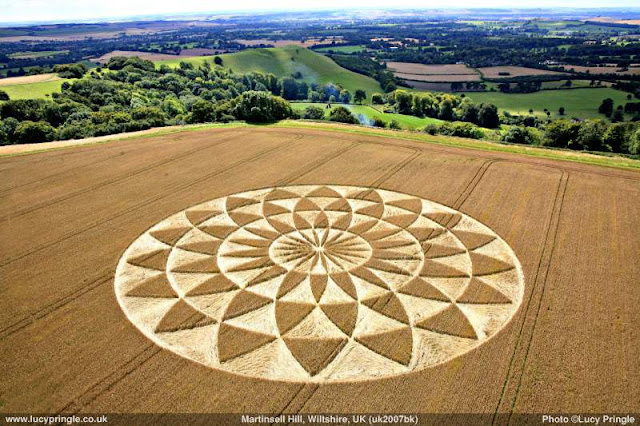What A Crop Circle Or Crop Formation Means? | Wikipedia
A crop circle or crop formation is a pattern created by flattening a crop,[1] usually a cereal. The term was first coined in the early 1980s by Colin Andrews.[2] Crop circles have been described as all falling "within the range of the sort of thing done in hoaxes" by Taner Edis, professor of physics at Truman State University.[3] Although obscure natural causes or alien origins of crop circles are suggested by fringe theorists,[4] there is no scientific evidence for such explanations, and human causes are consistent for all crop circles.[5][6][7]
The number of crop circles has substantially increased from the 1970s to current times. There has been little scientific study of them. Circles in the United Kingdom are not spread randomly across the landscape but appear near roads, areas of medium to dense population and cultural heritage monuments, such as Stonehenge or Avebury.[8] In 1991, two hoaxers, Bower and Chorley, took credit for having created many circles throughout England after one of their circles was described by a circle investigator as impossible to be made by human hand.[9]
Formations are usually created overnight,[10] although some are reported to have appeared during the day.[11] In contrast to crop circles or crop formations, archaeological remains can cause cropmarks in the fields in the shapes of circles and squares, but they do not appear overnight, and they are always in the same places every year.
History
The concept of "crop circles" began with the original late-1970s hoaxes by Doug Bower and Dave Chorley (see Bower and Chorley, below).[12][13][14][15][16] They said that they were inspired by the Tully "saucer nest" case in Australia, where a farmer found a flattened circle of swamp reeds after observing a UFO.[13]
Early reports of circular formations
A 1678 news pamphlet The Mowing-Devil: or, Strange News Out of Hartfordshire is claimed by some cereologists to be the first depiction of a crop circle.[12] Crop circle researcher Jim Schnabel does not consider it to be a historical precedent because it describes the stalks as being cut rather than bent.[12] (see folklore section)
In 1686, British naturalist Robert Plot reported on rings or arcs of mushrooms (see fairy rings) in The Natural History of Stafford-Shire and proposed air flows from the sky as a cause.[17][18] In 1991 meteorologist Terence Meaden linked this report with modern crop circles, a claim that has been compared with those made by Erich von Däniken.[n 1]
An 1880 letter to the editor of Nature by amateur scientist John Rand Capron describes how a recent storm had created several circles of flattened crops in a field.[n 2]













Post a Comment